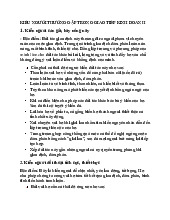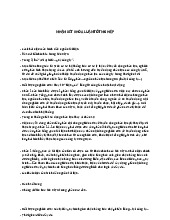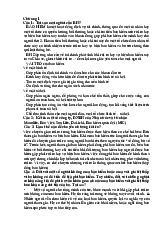Đang tải lên
Vui lòng đợi trong giây lát...
Preview text:
lOMoAR cPSD| 48302938 2 /15/ 22 Peasant Economics (Kinh tế nông hộ)
Instructor: Luu Van Duy, Ph.D.
Faculty of Economics and Rural Development 2 /15/ 22
Department of Agricultural Economics and Policies 1 Instructor Telephone No. 0987912915 Address: Room No. 407, Administrative Building, VNUA Email: Luuvanduy@gmail.com Luuvanduy@vnua.edu.vn 2
General information of the course • Code: KTE03014
• No. Credit: 02 (Theory: 1.5 – Practice: 0.5) 1 lOMoAR cPSD| 48302938 2 /15/ 22 • Self-study: 0
• Total hours for learning activities: 30 hours • Theory: 22.5 hours
• Discussion: 7.5 hours • Self-study: 60 hours
• According to individual plan or lecturer’s guideline 3 Course evaluation • Attendance - 10 %
• Midterm examination - 30%: (Group work)
• Final examination: 60% (Writing exam) 4 References
1. Frank Ellis (1993). Peasant Economics. CAMBRIDGE UNIVERSITY PRESS.
2. A. Haroon Akram-Lodhi, Cristóbal Kay (2010). Peasants and
Globalization: Political economy, rural transformation and the agrarian question. Routledge.
3. Jan Douwe van der Ploeg (2008). The New Peasantries: Struggles for
Autonomy and Sustainability in an Era of Empire and Globalization.
4. Jan Douwe van der Ploeg (2013). Peasants and the Art of Farming: A
Chayanovian Manifesto. Agrarian Change and Peasant Studies Series.
5. Henry Bernstein (2010). Class Dynamics of Agrarian Change. Agrarian
Change and Peasant Studies Series.
6. Đào Thế Tuấn (1997). Kinh tế hộ nông dân.
7. Trần Đình Đằng, Đinh Văn Đãn, Nguyễn Văn Quý, Đỗ Văn Viện (1996). Kinh tế hộ nông dân. 5 lOMoAR cPSD| 48302938 2 /15/ 22
Introduce about yourself.
What are your expectations from this course? 6 Course outline 1 . Basic concepts
2 . The peasant economic theories 3
. Contents of studying on peasant economics
4 . Social – economic behaviors of farm households 5
. Development of peasant economics in Vietnam 7 3 lOMoAR cPSD| 48302938 2 /15/ 22 CHAPTER 1
Introduction of peasant economics 8 Key words Economics ? Peasant? Peasant Economics ? 9 lOMoAR cPSD| 48302938 2 /15/ 22 Economics: Social science relates to people’s behavior in resources distributi
on and uses. People try to find out the way to distribute and use
their scarcity resources in order to obtain their objective
production s with minimum resources costs. Peasant economics:
Social science studies social and economic behavior of peasant households What is economics? 10 11 5 lOMoAR cPSD| 48302938 2 /15/ 22 Peasant? Peasant? Peasantry? Peasantry and farmer? 12 Group work #1
Read sub-section The fate of the peasantry and the
agrarian question (Page 3-6) in the textbook
Peasants and Globalization: Political economy, rural
transformation and the agrarian question and prepare a
presentation (PPT) to answer the following questions: Who are the peasant? What is peasantry?
The differences between peasant and farmer?
What does authors viewpoint of the fate of the peasantry in the globalization?
10-15 mins for each group to present your piece. 13 lOMoAR cPSD| 48302938 2 /15/ 22
1.1 Why are we studying/considering peasantry?
Account for nearly 70% of total population, 50% of total labor amount, and 75% rural labors.
Use and management of most of natural resources: land, forest, marine resources
Important political people who are very sensitive to the socio- economic situation.
Agriculture is a crucial economic sector
Poverty rate is still in rural areas
Peasant household economics is an important part of the
rural economy and national economics
“TAM NÔNG” = Nông nghiệp – Nông dân – Nông thôn 15 7 lOMoAR cPSD| 48302938 2 /15/ 22
1.2 Peasant’s trend In
many places, peasant farm households are disappearing as a result of:
Industrialization ( landless farmers) and Land accumulation.
In some places, farm households are subsistence
existence creating the stability of the social structure in
rural areas ( subsistence farming) Elsewhere,
they are transforming company with
agricultural activities impacted by socio-economic
changes ( commercial farming). 16
1.3 Peasant household’s position
In term of economic aspect: peasant households are
considered as fringe of market economy because of:
One-foot joints in market and
Other foot keeps subsistence production.
In term of social aspect: they are poor people 17 lOMoAR cPSD| 48302938 2 /15/ 22
1.4 Characteristics of peasantry Be community
Farmers should be community-based approached instead of
individuals or household only.
Farmers are important part of society who hold typical cultural identity.
Be able to change and adapt to new context Colony pressure
Urbanization- industrialization, migration Climate changes
Market participation rate is low
Opportunity: Increase income, more diversified consumption
Challenges: low market power 18
1.4 Characteristics of peasantry (cont. )
Farmers are dependent Be economic coercion by
other social groups Surplus value would have
earned => Others Market power is low, imperfect competition market.
Differentiate among peasant society Farmers are not absolute homogeneous
Be coercive other farmers in the community
There is an non-market economic exchange and
imbalances between farm households. 19 9 lOMoAR cPSD| 48302938 2 /15/ 22
1.5 Definitions of household
Those who dwell under the same roof and compose a
family; ate meals together, and a common budget
(Weberster, economic dictionary; 1990).
Household is the basic unit related to the production,
reproduction, and other social activities (Martin, 1998).
Household is a collection of people with the same blood
clan, close ties with each other producing products to
preserve themselves and the community (Raul, 1989)
Household is a group of people who are the same or
different consanguinity, sharing a common roof and meals (Mege, 1989). 20
Criteria for household identification
The same blood clan or not Live in the common roof Share a budget Ate meal together Produce together Decision making together Marrige or not marrige
Living together, or not living together
Sharing land certificate/The same assets/budget Inheritance right Residential registration
Eat together/consume together Decision making together
Differentiate between household and family? 21
Differentiate between household and family Family Household lOMoAR cPSD| 48302938 2 /15/ 22
To be a social unit, and a To be a economic unit and cell of society used for economic analysis
The members have blood tie The members have the same blood tie or not
Including many member Including only one households household
-> Family become a household when its members have the same economic source.
-> Household become a family when its members have the same blood tie.
Family is the basic unit forming household, family is a basic household. 22
Differentiate between household and family (cont.) Household’s function Family’s function Create products Create human resources Reproduction of labour Social activities source Build household’s budget 23
1.6 Definition of peasant household
Peasant households are households which derive their
livelihoods mainly from agriculture, utilize mainly family
labor in farm production, and are characterized by partial
engagement in input and output markets which are often imperfect or incomplete.
HND Là hộ có phương tiện kiếm sống dựa trên ruộng đất
(1), chủ yếu sử dụng lao động gia đình (2) vào sản xuất,
luôn nằm trong hệ thống kinh tế rộng hơn (3) , nhưng về
cơ bản được đặc trưng tham gia từng phần vào thị trường
với mức độ không hoàn hảo (4). 11 lOMoAR cPSD| 48302938 2 /15/ 22 24
1.7 Main features of farm household economics Two sides nature:
Both family household and business unit
Both production and consumption
Agriculture is the main occupation
Land is an important production input Mainly use family labour
Hired labour in peak period of harvesting Work for hire 25
1.7 Main features of farm household economics (cont.)
Difficult to identify household’s production profit:
Inputs for production are from domestic HH and from the market
Outputs for both sale and consumption Use family labour
Production inputs use for both production and domestic purpose.
Example: The cart is used for both transportation of production
inputs and household’s consumption (firewood and luggage transportation) TPr = TR-TC TR= P*Q. TC=FC+VC
-> MI=VA-Tax-Fees-Hired labour (if any)-Depreciation (khấu hao).
VA = GO-IC. GO=P*Q. IC = all inputs bought by cash.
Subsistence is the typical feature of household
Most outputs for consumption lOMoAR cPSD| 48302938 2 /15/ 22
Partial participation in market (both input and output market) 26
Partial participation in market (both input and output market)
Inputs: from HH and from the market-> partial participation in input market
Outputs: for HH consumption and sale-> partial
participation in output market 27
1.8 Market which farmers engage
Capital markets are fragmentary or non-existent.
Peasants access credit from local landlords, merchants, or
moneylenders at rates of interest which reflect the individual
circumstances of each transaction, not a market clearing condition.
Credit and rates of interest may be tied to other factor prices like land and
labour within a dependent economic relationship.
-> input market may be locked together.
Production inputs are erratically available or unavailable; their quality may vary; difficult to access.
Market information is poor, erratic, fragmentary, high cost for accessing outside community.
Land market does not always exist. 13 lOMoAR cPSD| 48302938 2 /15/ 22
Market and communications in general are not well integrated and
depending on infrastructure. 28
Differentiate peasant households and largescale farming households Criteria Peasant Large-scale farming Production size Small Large Manager Farmer Businessman Production targets Subsistence and commercial commercial purposes purposes Inputs
Household’s service and market Market Labor source Mainly family labor Hire wage labors, Activities Diverse and non-market Single Market Low High engagement Target Socio- economics Economics Decision making Driven by market signals and Driven by market household’s targets signal 29
1.9 Determinants on development of
pesant farm household economics
Household head’s education level/professional skills Household size Labour quality Natural conditions
Socio-economic conditions: Resources, intra and extra household relationships Labour skills Market And policies 30 lOMoAR cPSD| 48302938 2 /15/ 22
1.10 Aspects of peasant household analysis Economic aspect Cultural aspect Social aspect Anthropology Technology Comunity 31
1.11 Urgent issues are facing peasants in rural are as
How to modernize farm household economics?
How to integrate rural development into national developement?
How do we do to reduce the poor? 32 15




